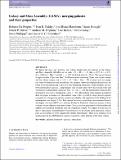Files in this item
Galaxy and Mass Assembly (GAMA) : merging galaxies and their properties
Item metadata
| dc.contributor.author | De Propris, Roberto | |
| dc.contributor.author | Baldry, Ivan K. | |
| dc.contributor.author | Bland-Hawthorn, Joss | |
| dc.contributor.author | Brough, Sarah | |
| dc.contributor.author | Driver, Simon P. | |
| dc.contributor.author | Hopkins, Andrew M. | |
| dc.contributor.author | Kelvin, Lee | |
| dc.contributor.author | Loveday, Jon | |
| dc.contributor.author | Phillipps, Steve | |
| dc.contributor.author | Robotham, Aaron S. G. | |
| dc.date.accessioned | 2014-11-21T17:31:02Z | |
| dc.date.available | 2014-11-21T17:31:02Z | |
| dc.date.issued | 2014-11-01 | |
| dc.identifier | 157934258 | |
| dc.identifier | bcd5d5a6-48a2-44c3-a90c-686fe92a14ba | |
| dc.identifier | 000343399600019 | |
| dc.identifier | 84908420634 | |
| dc.identifier | 000343399600019 | |
| dc.identifier.citation | De Propris , R , Baldry , I K , Bland-Hawthorn , J , Brough , S , Driver , S P , Hopkins , A M , Kelvin , L , Loveday , J , Phillipps , S & Robotham , A S G 2014 , ' Galaxy and Mass Assembly (GAMA) : merging galaxies and their properties ' , Monthly Notices of the Royal Astronomical Society , vol. 444 , no. 3 , pp. 2200-2211 . https://doi.org/10.1093/mnras/stu1452 | en |
| dc.identifier.issn | 0035-8711 | |
| dc.identifier.uri | https://hdl.handle.net/10023/5830 | |
| dc.description.abstract | We derive the close pair fractions and volume merger rates for galaxies in the Galaxy and Mass Assembly (GAMA) survey with -23 <M-r <-17 (Omega(M) = 0.27, Omega(A) = 0.73, H-0 = 100 km s(-1) Mpc(-1)) at 0.01 <z <0.22 (look-back time of <2 Gyr). The merger fraction is approximately 1.5 per cent Gyr(-1) at all luminosities (assuming 50 per cent of pairs merge) and the volume merger rate is approximate to 3.5 x 10(-4) Mpc(-3) Gyr(-1). We examine how the merger rate varies by luminosity and morphology. Dry mergers (between red/spheroidal galaxies) are found to be uncommon and to decrease with decreasing luminosity. Fainter mergers are wet, between blue/discy galaxies. Damp mergers (one of each type) follow the average of dry and wetmergers. In the brighter luminosity bin (-23 <M-r <-20), the merger rate evolution is flat, irrespective of colour or morphology, out to z similar to 0.2. The makeup of the merging population does not appear to change over this redshift range. Galaxy growth by major mergers appears comparatively unimportant and dry mergers are unlikely to be significant in the buildup of the red sequence over the past 2 Gyr. We compare the colour, morphology, environmental density and degree of activity (BPT class, Baldwin, Phillips & Terlevich) of galaxies in pairs to those of more isolated objects in the same volume. Galaxies in close pairs tend to be both redder and slightly more spheroid dominated than the comparison sample. We suggest that this may be due to 'harassment' in multiple previous passes prior to the current close interaction. Galaxy pairs do not appear to prefer significantly denser environments. There is no evidence of an enhancement in the AGN fraction in pairs, compared to other galaxies in the same volume. | |
| dc.format.extent | 12 | |
| dc.format.extent | 2186359 | |
| dc.language.iso | eng | |
| dc.relation.ispartof | Monthly Notices of the Royal Astronomical Society | en |
| dc.subject | galaxies: formation | en |
| dc.subject | galaxies: interactions | en |
| dc.subject | Digital sky survey | en |
| dc.subject | Similar-to 1 | en |
| dc.subject | Supermassive black-holes | en |
| dc.subject | Star-forming galaxies | en |
| dc.subject | Luminous red galaxies | en |
| dc.subject | Merger rate evolution | en |
| dc.subject | Cold dark-matter | en |
| dc.subject | Less-than 1.5 | en |
| dc.subject | Redshift survey | en |
| dc.subject | Elliptic galaxies | en |
| dc.subject | QC Physics | en |
| dc.subject | QB Astronomy | en |
| dc.subject.lcc | QC | en |
| dc.subject.lcc | QB | en |
| dc.title | Galaxy and Mass Assembly (GAMA) : merging galaxies and their properties | en |
| dc.type | Journal article | en |
| dc.contributor.institution | University of St Andrews. School of Physics and Astronomy | en |
| dc.identifier.doi | 10.1093/mnras/stu1452 | |
| dc.description.status | Peer reviewed | en |
This item appears in the following Collection(s)
Items in the St Andrews Research Repository are protected by copyright, with all rights reserved, unless otherwise indicated.

